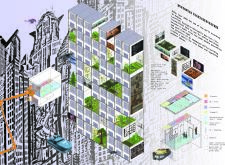5 key facts about this project
Innovative Multi-Functional Design
This project stands out due to its modular approach, featuring stackable living units divided by vegetated zones. Each unit incorporates space for outdoor gardens, allowing residents to engage in food cultivation and establish a personal connection with nature. This design facilitates a self-sustaining ecosystem within an urban setting by integrating vegetation into the living experience. The communal areas are strategically positioned throughout the building to encourage social interaction among residents, countering the isolation often felt in metropolitan environments.
Key components include flexible interior layouts that adapt to individual needs, promoting an open living concept. Additionally, the incorporation of green roofs enhances insulation and biodiversity, contributing to environmental sustainability. The project employs advanced building technologies, incorporating systems for water collection and automated energy management to achieve efficient resource utilization. These elements underscore a unique commitment to reducing the building's ecological footprint.
Technological Integration and Materiality
The architectural language of the "Dystopian Vegetated Matrix" is defined by the interplay of glass and steel. The extensive use of glass for façades optimizes natural light and provides visual access to the gardens. Steel serves as the primary structural material, offering durability and flexibility essential for the project’s modular design. The application of recycled materials further emphasizes the project's sustainability goals.
In summary, the "Dystopian Vegetated Matrix" marks a step toward rethinking urban architecture. By merging residential spaces with nature and community interaction, this project offers a viable model for future urban living. For a comprehensive understanding of its architectural features, including architectural plans, architectural sections, and detailed architectural designs, a thorough review of the project presentation is encouraged. This exploration will provide deeper insights into the innovative ideas driving this architectural endeavor.























